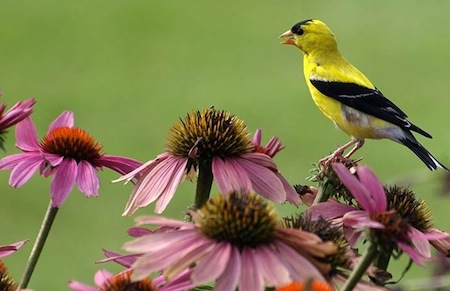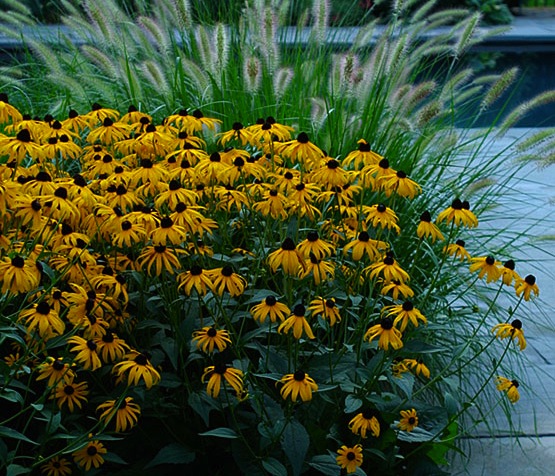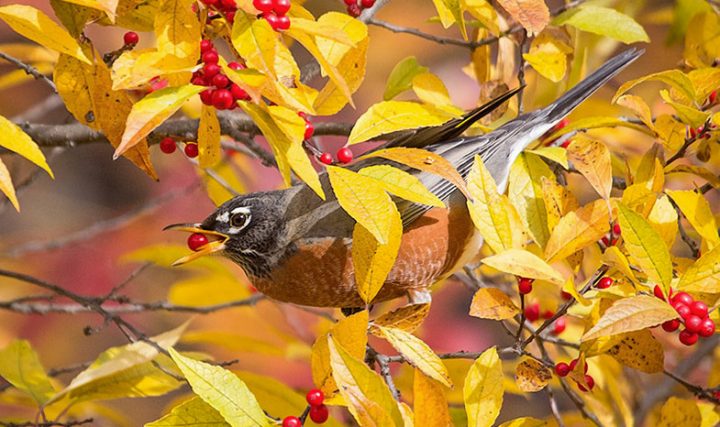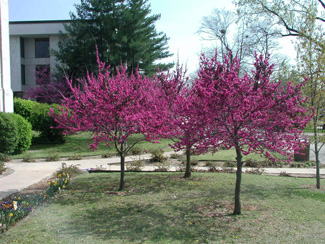Gardening for the Birds

Goldfinch on coneflower
By Pat Dickey, Fairfax Master Gardener
Bird watching has increased in popularity, especially among those who love the outdoors and being close to nature. Many of us are discovering, however, that birds aren’t naturally attracted to homes with mowed lawns and wide open spaces. It is important to evaluate your yard from a bird’s eye view. Birds want to raise their young where there are food sources, water, and places for nesting and shelter. To see many colorful species of birds in your landscape, why not create a plan to provide an inviting habitat for them?
Bird populations respond well to areas that have vegetative layering, with plants at different heights and densities. Here are some native plants that will provide food and shelter for your birds.

Rudbeckia fulgida
- The tallest are the large canopy trees, such as oak (Quercus spp.) and red maple (Acer rubrum).
- Eastern red cedar (Juniperus virginiana), pine (Pinus spp.), and spruce (Picea spp.) are conifers that provide seed-filled cones for birds.
- Understory trees and shrubs that grow beneath the taller trees and provide fruit and berries include serviceberry (Amelanchier arborea), redbud (Cercis canadensis), dogwood (Cornus florida), Viburnum spp., elderberry (Sambucus canadensis), and spicebush (Lindera benzoin).
- At ground level are the perennials and annuals with seeds that birds like, such as the sunflowers (Helianthus spp.), coneflowers (Echinacea purpurea) and orange coneflowers (Rudbeckia fulgida), asters (Aster spp.), and tickseed (Coreopsis spp.). Remember not to deadhead your flowers at the end of the season so that the birds can feast on these seeds.
 Before purchasing anything for your bird garden, draw a diagram of your yard and include your existing trees and shrubs. Then add tracing paper over it, sketching in new plants that you may want to purchase to see where they will fit. In your plans, avoid planting in straight lines. Create meandering paths and develop secluded areas where birds can nest and hide from their predators. Then visit a respected local nursery to look for native trees, shrubs, perennials, and annuals that birds would normally choose for their fruit, berries, and seeds. Make sure you ask how large the plants will grow in their maturity. For those of you who don’t have large yards, hang bird feeders and use containers for perennials, annuals, and smaller shrubs that attract birds. A bird feeder can also offer a great opportunity for bird watching. It should be hung six feet above ground and several feet away from windows to keep birds from flying into the glass. Look for a feeder that is squirrel-proof. Black oiled sunflower seeds are favorites for many species of birds.
Before purchasing anything for your bird garden, draw a diagram of your yard and include your existing trees and shrubs. Then add tracing paper over it, sketching in new plants that you may want to purchase to see where they will fit. In your plans, avoid planting in straight lines. Create meandering paths and develop secluded areas where birds can nest and hide from their predators. Then visit a respected local nursery to look for native trees, shrubs, perennials, and annuals that birds would normally choose for their fruit, berries, and seeds. Make sure you ask how large the plants will grow in their maturity. For those of you who don’t have large yards, hang bird feeders and use containers for perennials, annuals, and smaller shrubs that attract birds. A bird feeder can also offer a great opportunity for bird watching. It should be hung six feet above ground and several feet away from windows to keep birds from flying into the glass. Look for a feeder that is squirrel-proof. Black oiled sunflower seeds are favorites for many species of birds.
If you don’t have a natural source of water for your visiting birds, use a raised birdbath or a ground container to create an artificial pond. The rim for perching should have a rough surface for easier footing. Be sure that the birdbath or pond is made of a material that will withstand cold temperatures and will not crack when frozen. Place the water source near shrubs and low trees for a bird’s easy escape, but not too close to possible predators. For continued use in the winter, install a small heater. Be careful not to contaminate your birdbath or pond with fertilizer, and keep it free of mosquitoes and bacteria. Replenish it with fresh water every two or three days.

Redbud
Birds enjoy a habitat with different layers of trees and shrubs for shelter and dense areas for their nesting and secluded perching. Dead trees called snags can remain in your bird garden if they are not a danger to neighbors or property. The snags will attract insects that are important food for birds. Birds will also take shelter in dead, hollowed-out trees. Another means for shelter is to create a brush pile with dead limbs in the corner of your yard. The birds will hunt, roost, and nest there. Insects will also tunnel under the limbs and will be a continued food source. Nesting boxes are also welcome by some species, such as eastern bluebirds, chickadees, titmice, purple martins, tree swallows, downy woodpeckers, northern flickers, and wrens. Be sure to allow for ventilation and drainage. The entry holes should be a size suitable for the birds you want to attract. Do not attach perches to the nesting boxes, as they will attract predators. Clean the nesting boxes after you are sure that the fledglings have left their nests.
Don’t forget to purchase a bird field guide and binoculars. Enjoy your garden!
Resources
• Attracting Birds, National Wildlife Federation’s Center for Wildlife
• Creating a Garden for Birds, Bird Notes from Sapsucker Woods, Cornell Lab of Ornithology
• Creating Inviting Habitats, Virginia Cooperative Extension,
Publication HORT-59NP
• The Best Trees, Vines, and Shrubs to Plant for Birds: a Starter List, Cornell University All About Birds
. . . updated 2023